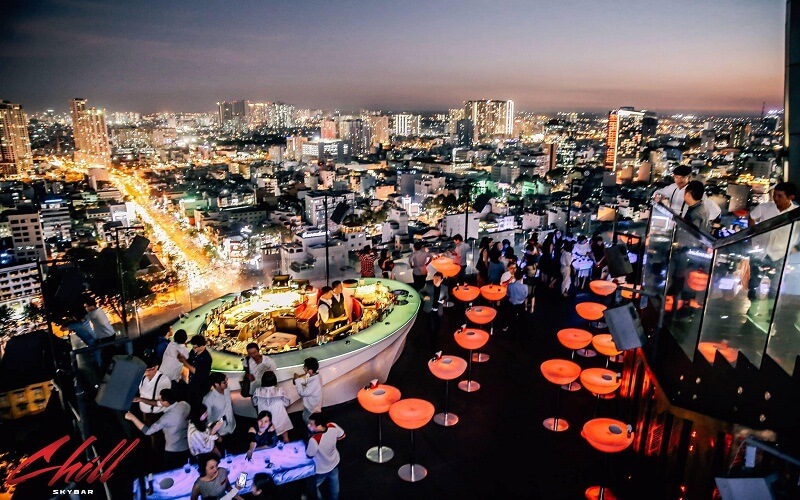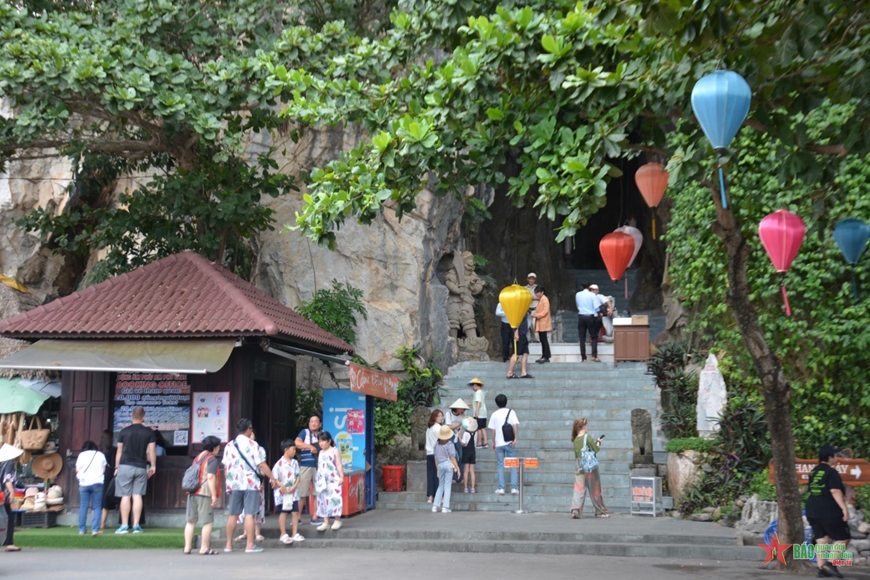The Imperial City of Hue is not only a historical destination but also an endless source of inspiration for those who love culture and history. When visiting the Imperial City, you’ll explore a rich architectural space filled with palaces, temples, pavilions, shrines, and gardens, each bearing the deep imprints of the ancient Nguyen Dynasty. To make the most of your trip to Hue, check out the travel guide below for ticket prices to the Imperial City and an itinerary for a meaningful and enjoyable journey.
Table of Contents
Overview of the Imperial City of Hue
With its ancient beauty and heroic history, the Imperial City of Hue has always been a popular destination for both domestic and international tourists. Let’s explore a detailed overview of the Imperial City below:
Introduction to the Imperial City of Hue
The Imperial City of Hue is situated along the banks of the romantic Perfume River. Its exact location is 23/8 Street, Thuan Hoa Ward, Hue City, Thua Thien Hue Province. This place is also known as the Hue Imperial Citadel, part of the Complex of Hue Monuments, reflecting the cultural, historical, and architectural legacy of the Nguyen Dynasty. In 1993, this site was recognized as a World Cultural Heritage by UNESCO.
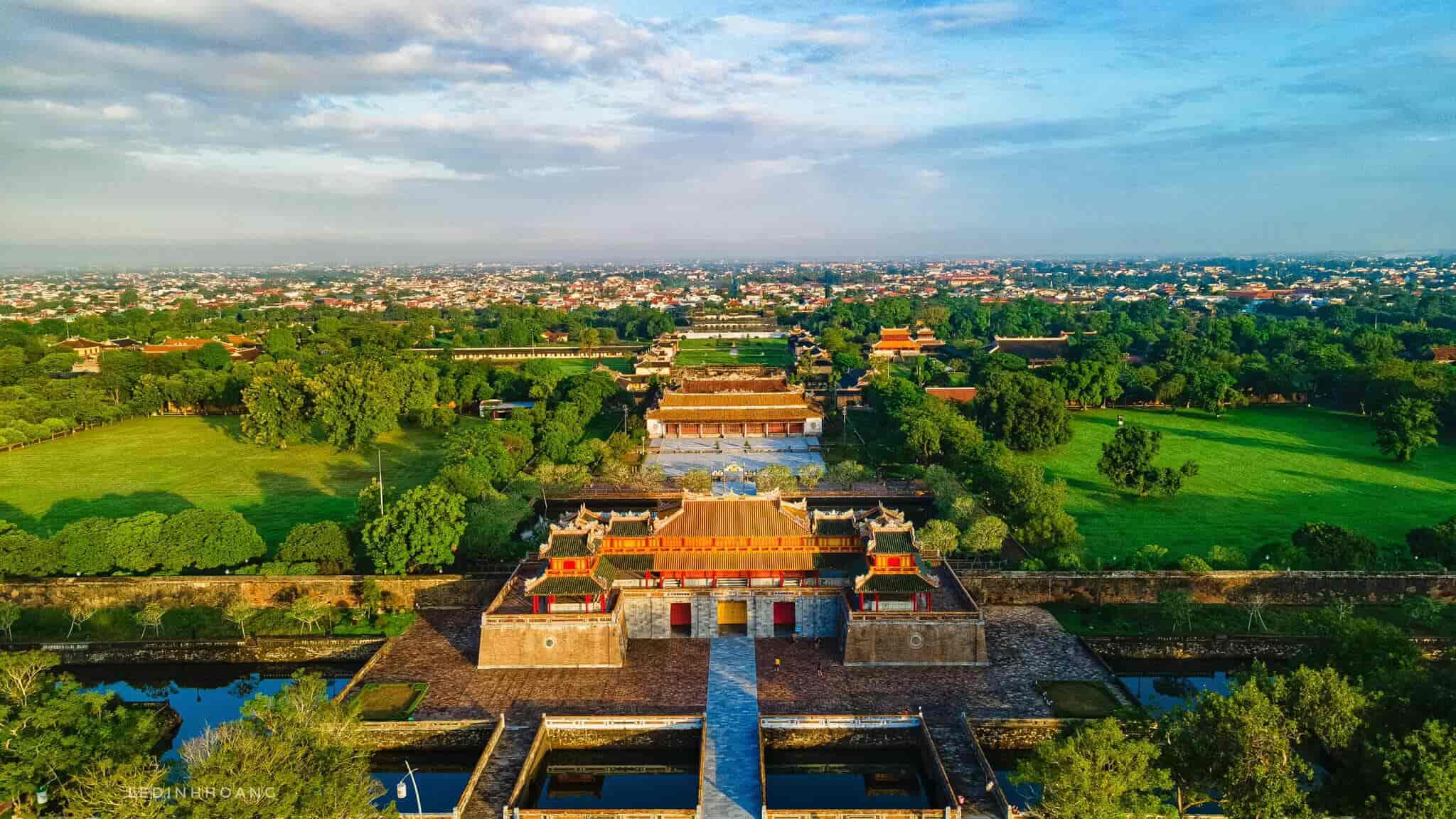
When visiting, tourists can also experience a variety of services, such as:
- Electric tour cars: Electric vehicles are available to take visitors around the Imperial City and all its attractions. These cars are quiet and emission-free, making for a peaceful and comfortable tour experience. Additionally, they are especially helpful for families with young children or elderly members, reducing the fatigue from walking long distances.
- Automatic audio guide service: This is an electronic application that automates narration for visitors, especially for international tourists and those who speak rare languages.
- Guided tour service: Visitors can register for a guided tour when purchasing tickets. Having a guide provides deeper insights into the Imperial City’s history and architecture, and also offers support for taking photos.
- Virtual Reality (VR) experience: Visitors have the chance to enjoy a simulated VR experience of the Hue Imperial Palace through digital films and VR technology. Services include VR spaceship simulation, VR lighthouse, VR telescope, and a VR tour of Khai Dinh Tomb.
- Traditional Hue craft demonstration space: This area showcases traditional products such as kite-making, conical hat-making, and paper flower crafting, along with a variety of royal souvenirs available for tourists.
- Royal costume photography: Inside the Hue Imperial Palace, tourists can dress in royal costumes such as those of emperors, queens, princesses, princes, and concubines for a memorable photoshoot. This is a unique opportunity to wear traditional garments and capture the experience.
History
The Imperial City of Hue was constructed from the early 19th century to the mid-20th century, intended as a residence and center for the activities of the Nguyen Dynasty emperors and the royal court.
In 1803, during the reign of Emperor Gia Long, he recognized Hue as a peaceful and poetic land with its picturesque landscape by the Perfume River, and thus, he chose it as the imperial capital of the Nguyen Dynasty. After about 30 years of construction, involving tens of thousands of laborers and soldiers who filled rivers, dug trenches, and built walls, the grand complex of the new capital was finally completed.
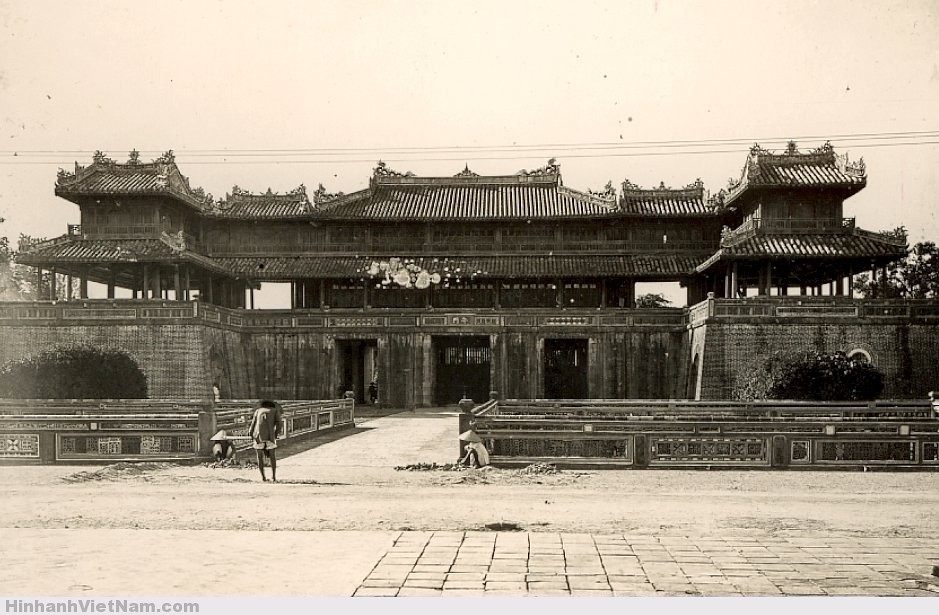
This site has witnessed many important historical events of the nation and is a treasure trove of beautiful and valuable ancient cultural and architectural heritage in Vietnam. Additionally, it houses numerous artifacts and documents related to the Nguyen Dynasty, offering visitors a deeper understanding of the life and activities of past emperors and their families.
The Imperial City is the second wall within the Hue Citadel, divided into two main areas:
- The Imperial Citadel includes the Ngo Mon Gate and the Thai Hoa Palace.
- The Forbidden Purple City is the private area reserved for the emperor and the royal family, consisting of Dai Cung Mon, Ta Vu and Huu Vu, Thai Binh Pavilion, Can Chanh Palace, Dien Tho Palace, and more.
Architectural Highlights
Covering an area of 360,000 m², with the front and rear walls measuring 622 meters and the left and right walls 604 meters, the interior features many grand architectural structures, intertwined with lush green vegetation. The architecture of the Imperial Citadel and the Forbidden Purple City has many remarkable features that attract visitors.
The Imperial City of Hue has a total of 13 gates, including 1 internal gate, 2 waterway gates, and 10 external gates:
- Chanh Bac Gate, also known as the Back Gate, located at the rear of the Imperial City.
- Tay Bac Gate, also called An Hoa Gate, located in the northwest of the Imperial City, connecting Tang Bat Ho and Nguyen Trai streets.
- Chanh Tay Gate, located to the west of the Imperial City on Thai Phien street.
- Tay Nam Gate (also known as Huu Gate), situated on the right side of the Imperial City.
- Chanh Nam Gate, located to the south, also called Nha Do Gate, as Vo Kho – a weapons storage facility built during Gia Long’s reign – is nearby.
- Quang Duc Gate, also known as Sap Gate, located to the south.
- The Nhon Gate, also called Ngan Gate, due to a high wall that once blocked the path leading to the river for the emperor, located to the south, on the left of Ky Dai.
- Dong Nam Gate, also known as Thuong Tu Gate because Thuong Ky Institute and the royal stables were situated inside this gate, located in the eastern corner of the southeast part of the Imperial City.
- Chanh Dong Gate, also known as Dong Ba Gate.
- Dong Bac Gate, also called Ke Trai Gate, located in the northeast corner.
The system of moats (called Ho Thanh Hao) is over 7 kilometers long. These moats not only served as a defense system but also functioned as waterways. The western part connects to Ke Van River, the eastern part to Dong Ba River, the northern part to An Hoa River, and the southern part integrates with the Perfume River.
Map of the Imperial City of Hue
The Imperial City of Hue, is a vast complex with various sections, and having a map can greatly enhance your visit. Here’s an overview of the key areas you might find on the map:
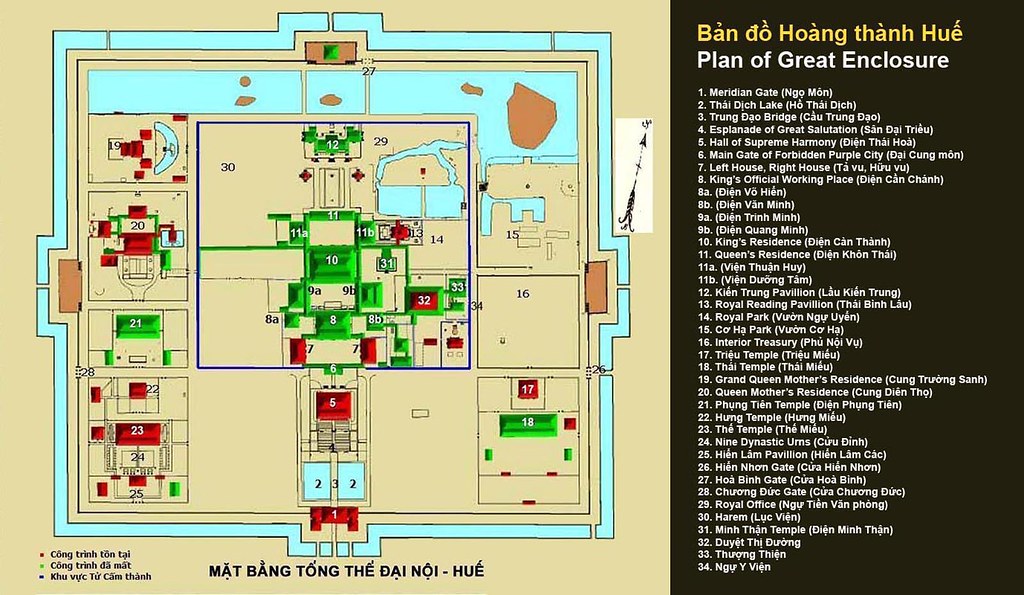
When is the Best Time to Visit the Imperial City of Hue?
The ideal time to visit the Imperial City of Hue is in the autumn, from September to November, or in the spring, from January to March. During these periods, the weather in Hue is generally dry, cool, and not too hot.
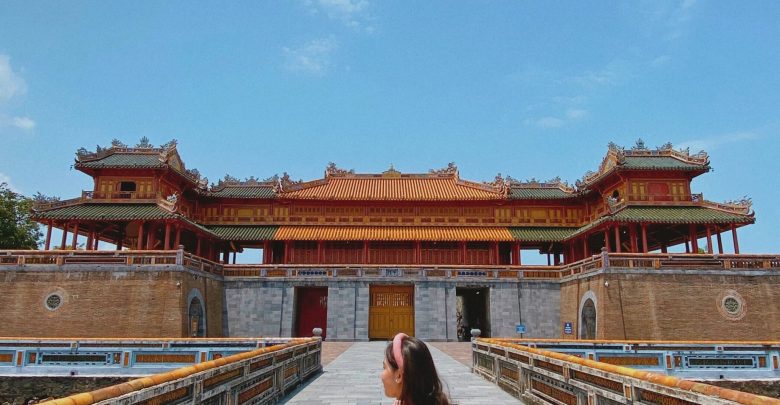
In particular, visiting Hue in the spring offers a chance to witness the vibrant scenery as trees and plants sprout and bloom, with streets filled with flowers. Additionally, you can enjoy the gentle breezes and breathe in the fresh, life-filled air amidst nature.
Furthermore, traditional festival periods like the Hue Festival from April to May each year are also great times to experience the local cultural atmosphere. This festival features numerous artistic performances and unique entertainment events. During the Hue Festival, the Imperial City and the entire city of Hue are adorned with a new, colorful, and splendid appearance.
See more about: When is the most beautiful time to visit Hue, Vietnam?
Getting to the Imperial City of Hue
To reach the Imperial City of Hue, there are several transportation options available depending on your budget and health.
Getting to Hue City
- By Airplane: For a quick and relaxing journey, flying is the best option. You can fly directly to Phu Bai International Airport. If your country does not have direct flights, you can fly to Ho Chi Minh City, Da Nang, or Hanoi and then take a domestic flight to Phu Bai. Once you arrive at Phu Bai Airport, you can choose between taking a shuttle bus (ticket price: 40,000 – 50,000 VND per person/one-way) or renting a car from VnCarRentals.com for a direct transfer to the city center.
- By Train: If you want to save money, taking a train from other provinces to Hue is a good option. Ticket prices range from 400,000 to 900,000 VND for a seat, and can be higher if you choose a train like SE3 or SE1 with sleeping compartments and air conditioning.
- By Car: You can also travel by long-distance bus from Hanoi (400,000 – 500,000 VND per ticket), Ho Chi Minh City (600,000 – 1,250,000 VND per ticket), or Da Nang. For travel between Da Nang and Hue, you can use Car Rental Danang to Hue from VnCarRentals services.
Getting to the Imperial City of Hue
The Imperial City is located right in the center of Hue, making it easy to access. To enjoy the picturesque scenery of Hue, you might consider renting a bicycle, motorbike, or cyclo. However, if traveling with young children or elderly family members, renting a car with a driver in Hue is the most suitable option.
Ticket Prices for the Imperial City of Hue
To visit the Imperial City of Hue, tickets can be purchased near the Ngo Mon Gate. The latest ticket prices for 2024 are as follows:
- Adults: 200,000 VND per person
- Children: 40,000 VND per person (ages 7 to 12)
- Children under 6 years old: Free
Attractions in the Imperial City of Hue
The Imperial City of Hue is not only a symbol of the Nguyen dynasty but also a treasure trove of unique cultural and architectural heritage. When visiting the Imperial City of Hue, you will explore a grand architectural complex that was once the political, cultural, and religious center of the Nguyen dynasty.
Ngo Mon Gate (Meridian Gate)
Ngo Mon Gate is the main gate of the Imperial City of Hue and one of the most famous and iconic structures within the complex. The gate is a monumental and grand construction with high, solid walls. Ngo Mon is not just an entrance but also serves as a prominent symbol of the imperial city, featuring multiple layers and a surrounding moat.
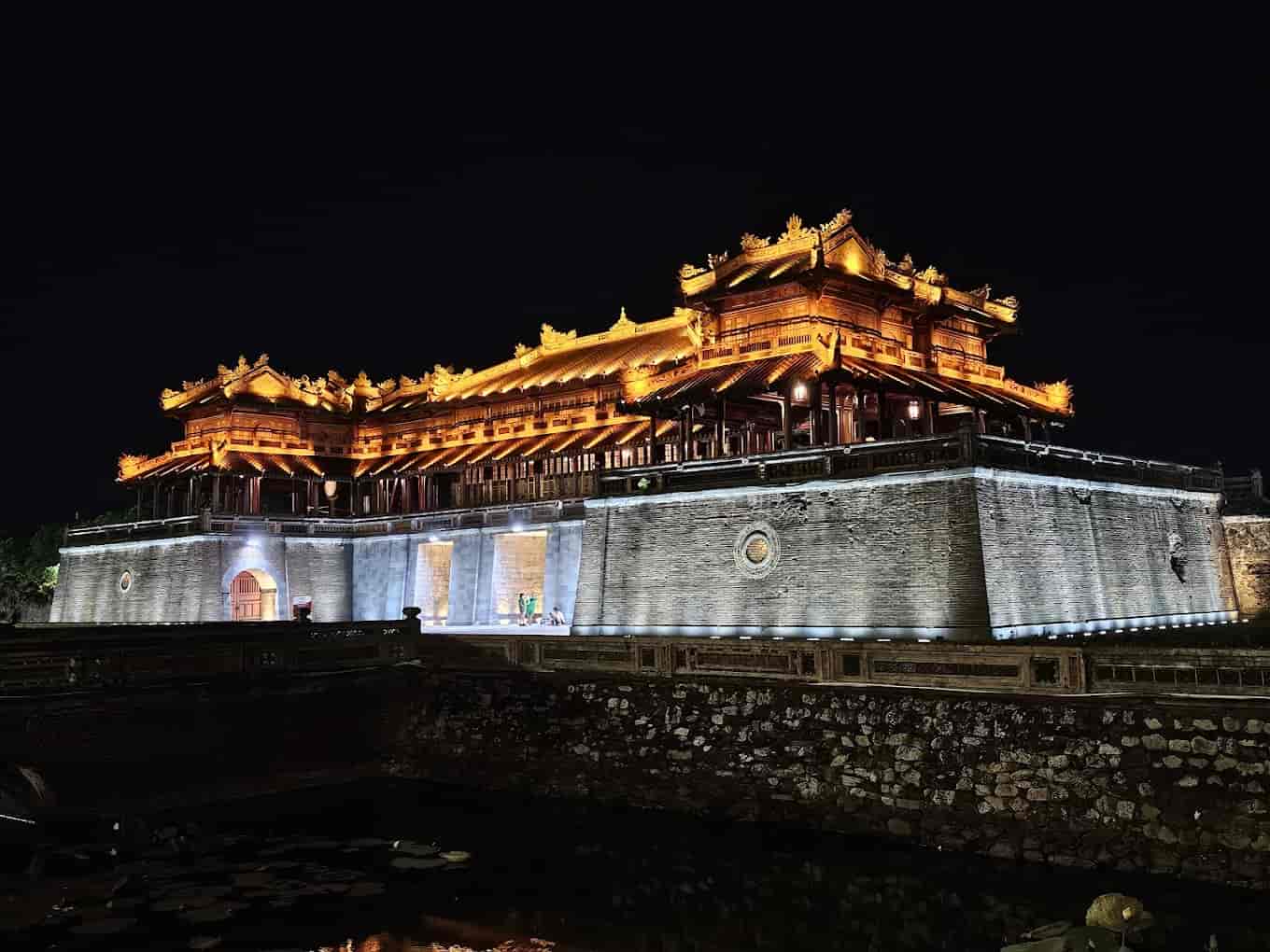
Facing south, the Ngo Mon Gate offers a picturesque view of the Perfume River. The gate has five entrances: the central gate was reserved for the emperor, the two side gates for civil and military officials, and the remaining gates for soldiers and attendants accompanying the emperor.
After nearly two centuries, Ngo Mon Gate has endured the test of time and remains an outstanding architectural masterpiece. Today, it is still considered a symbol of Hue and a must-visit attraction.
Thai Hoa Palace (Hall of Supreme Harmony)
Thai Hoa Palace represents the power of the Nguyen dynasty and is located within the Imperial City. It, along with the Dai Trieu Nghi Court, was used for the emperor’s court sessions. These sessions were usually significant state meetings.
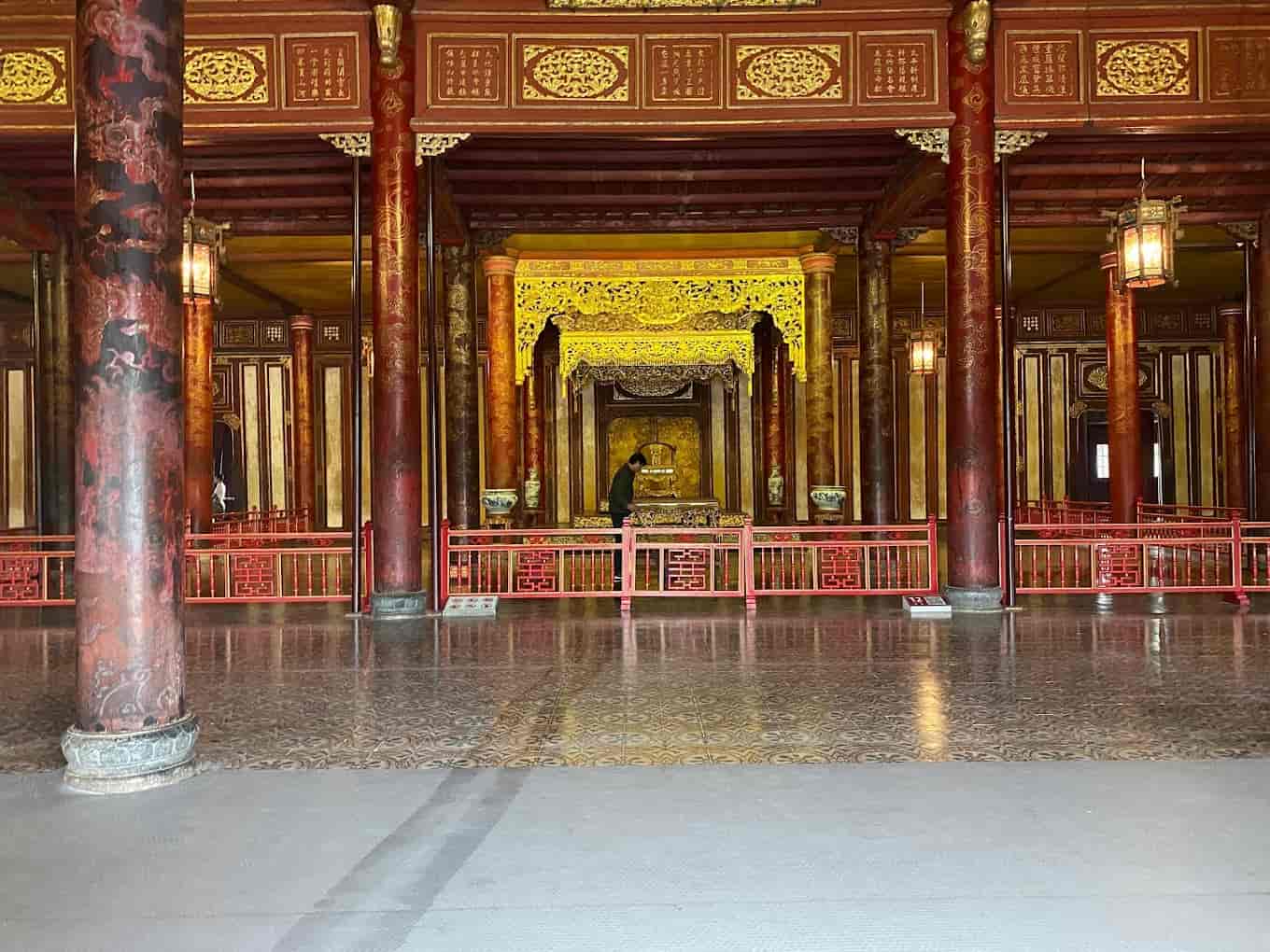
The palace features traditional Vietnamese architecture with the primary material being ironwood. The roof, columns, and other parts are intricately carved with dragon motifs. At the center of the palace is the emperor’s throne, placed in a prominent position for court meetings. Visiting Thai Hoa Palace provides insights into the life and activities of the Nguyen dynasty.
Dai Cung Mon (Main Gate of Forbidden city)
Dai Cung Mon, built in 1833, is the main gate (facing south) into the Forbidden Purple City and consists of five sections with three doors. Under Emperor Minh Mang, Dai Cung Mon symbolized the power and culture of the Nguyen dynasty. The central door was reserved for the emperor, while the side corridors connected to Tả Vu and Hữu Vu.
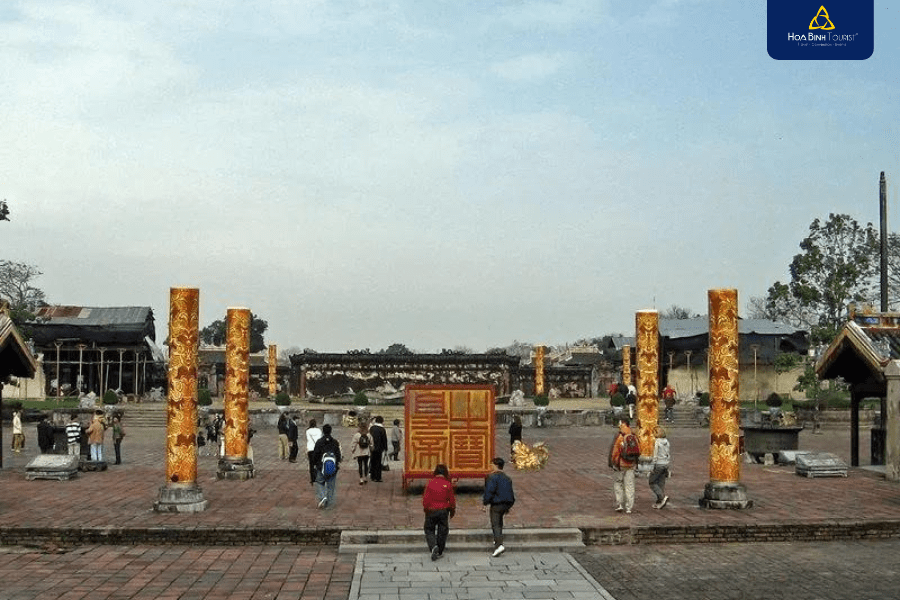
The gate faces the courtyard leading to Thai Hoa Palace and is constructed entirely of wood, with a roof covered in yellow-glazed tiles. The structure was damaged during the war and is currently being studied for restoration by the Hue Monuments Conservation Center.
Ta Vu and Huu Vu (Left House, Right House)
Opposite Can Chanh Palace are the Ta Vu and Huu Vu buildings, constructed in the early 19th century. Hữu Vu was used by military officials, while Ta Vu was for civil officials.
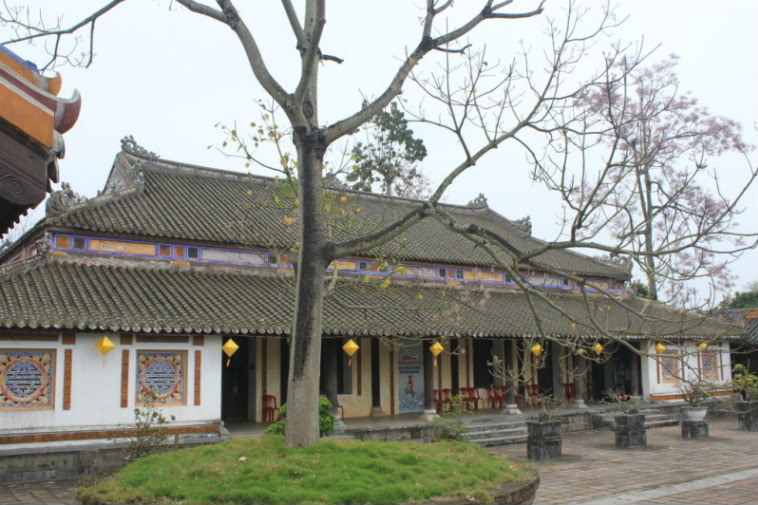
These buildings were used for preparations before court ceremonies and for holding examinations or banquets. Today, Ta Vu displays valuable artifacts, while Huu Vu is open for visitors to explore and photograph.
Can Chanh Palace (King’s official working Place)
Can Chanh Palace aligns with Thai Hoa Palace from north to south and was used by the emperor for court sessions. Next to it are Can Thanh Palace and Khôn Thái Palace. Notable for its large and beautiful wooden structure, Can Chanh Palace features limwood columns and intricately carved upper frameworks, showcasing exquisite craftsmanship.
Thai Binh Pavilion
Thai Binh Pavilion, built between 1919 and 1921 by Emperor Khai Dinh, is located within the Forbidden Purple City. It was used by the emperor for relaxation, reading, writing, or composing poetry. The area maintains a beautiful traditional architectural style, preserving the natural beauty of the surroundings.
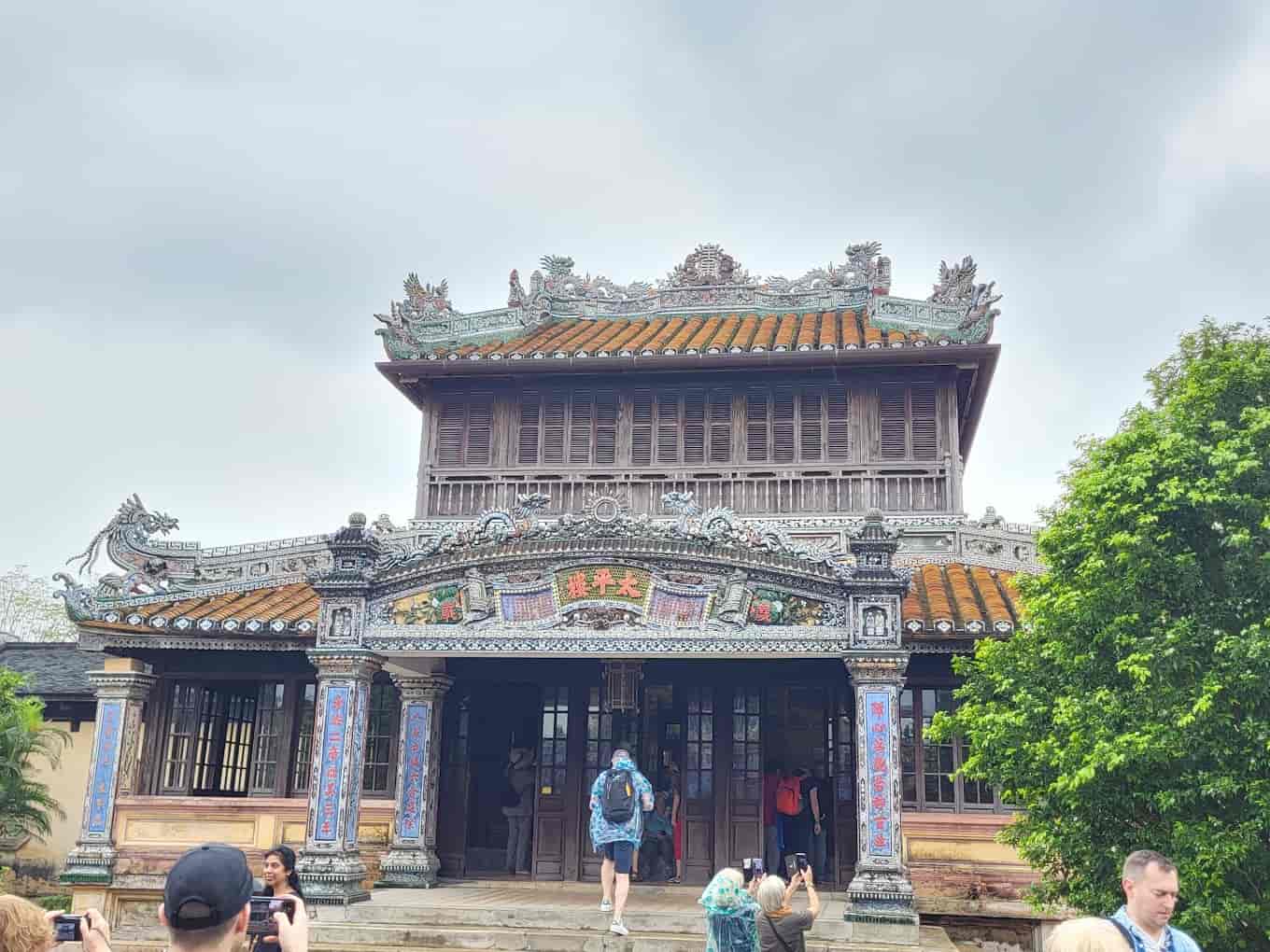
Cung Dien Tho (Queen Mother’s Residence)
Cung Dien Tho is located in the western part of the Forbidden Purple City and is bordered to the north by Phung Tien Palace and to the south by Truong Sanh Palace. It consists of more than 10 buildings arranged within a rectangular walled compound, covering an area of up to 15 hectares. This palace complex was the residence of the Empress Dowagers and other powerful women in the royal court. The intricate architecture of Cung Dien Tho reflects the power and status of these influential women during that era.
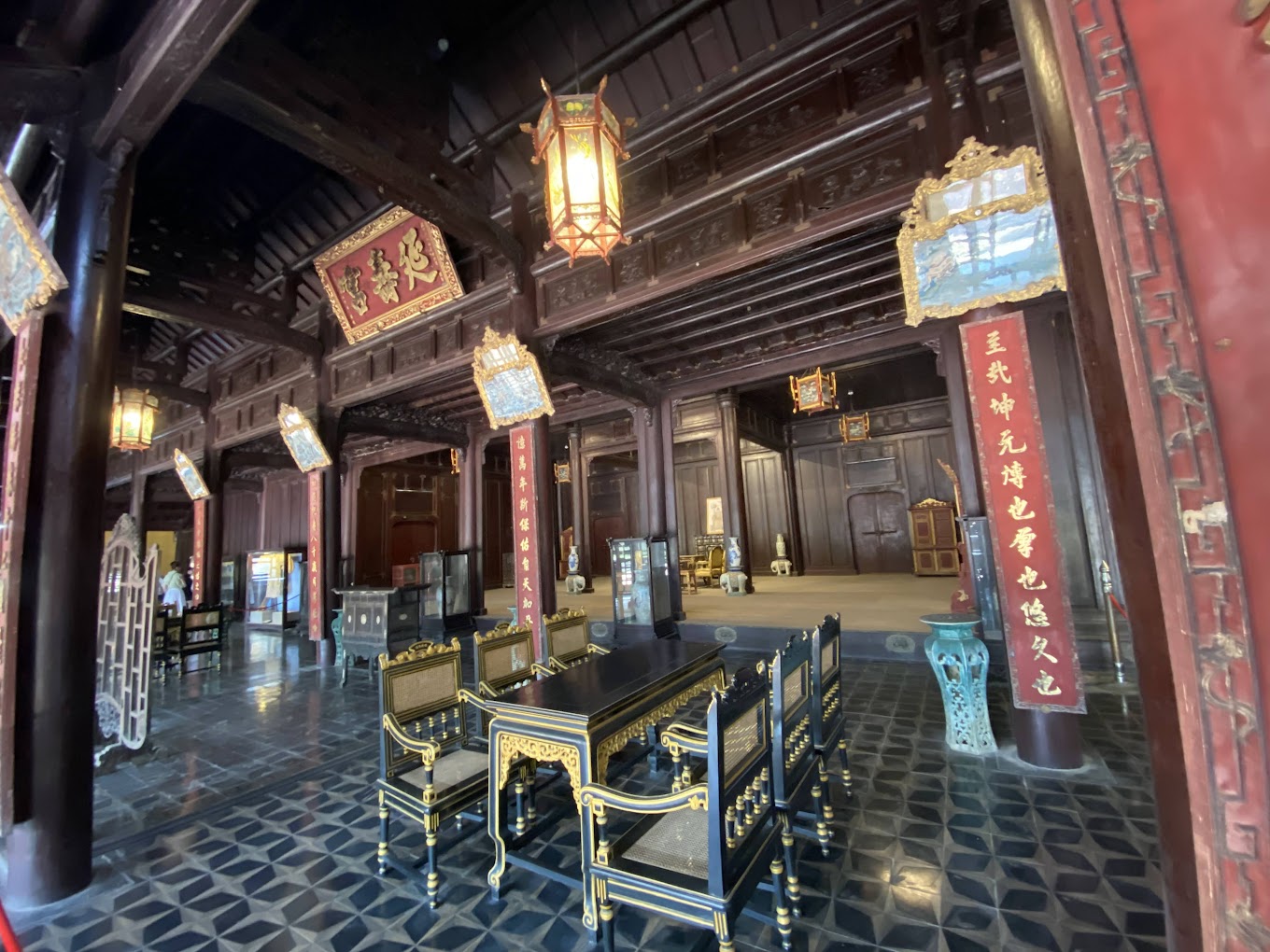
Cung Dien Tho includes several notable buildings:
- Main Hall: The central building where important ceremonies and events took place.
- Ta Tra House: Used as a resting place and tea room for the queens.
- Tinh Minh Pavilion: Dedicated to spiritual practices and prayers.
- Khuong Ninh and Ta Truong Du: These buildings were used for daily activities and administrative purposes.
Among the many palaces that still exist in the Imperial City of Hue after the war, Cung Dien Tho is considered one of the
Kien Trung Palace
Kien Trung Palace, also known as Kien Trung Pavilion, was constructed during the reign of Emperor Khai Dinh (1921-1923). The term “Kien” means to build or establish, while “Trung” implies uprightness.
In 1876, Minh Vien Pavilion was dismantled due to severe deterioration. It wasn’t until the reign of Emperor Duy Tan that the court decided to build a new structure in a modern style. By 1916, Emperor Khai Dinh renamed it Kien Trung Pavilion and commissioned a larger construction with a blend of Asian and European architectural styles. This structure was considered the residence of the emperor and is noted for its significant association with Emperor Khai Dinh.
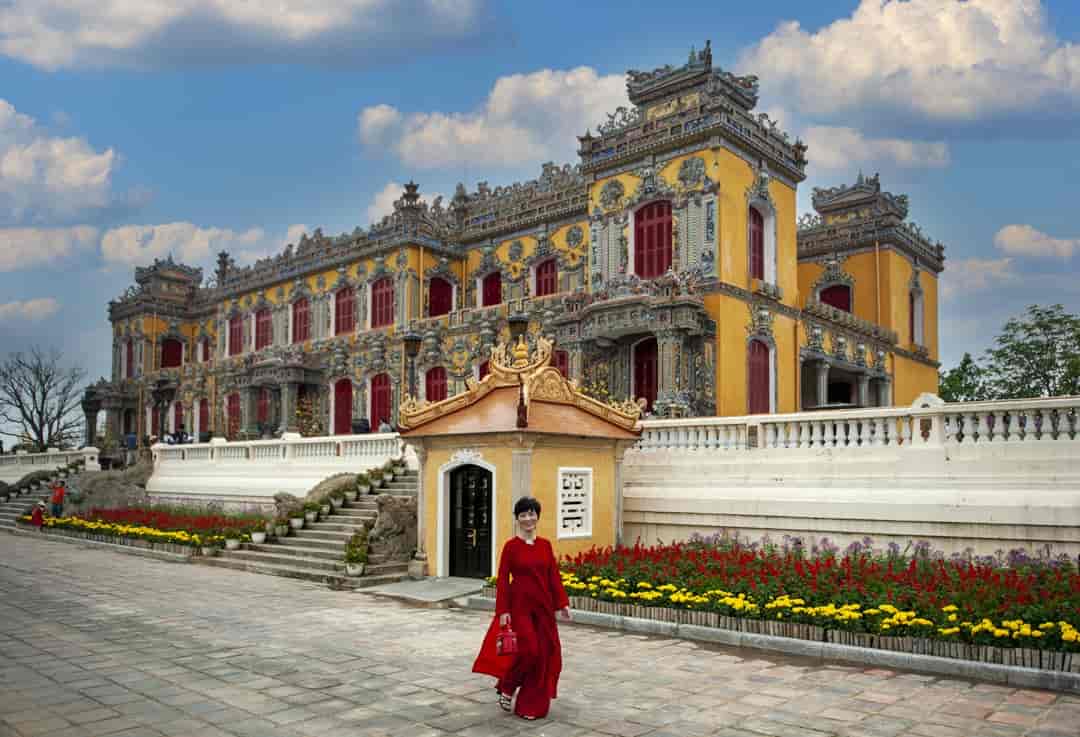
During Emperor Bao Dai‘s reign, Kien Trung Palace was renovated in a Western style and became the residence of the royal family. It was here that Queen Nam Phuong gave birth to Crown Prince Bao Long. However, in February 1947, the palace was completely destroyed due to the war.
After 72 years of silence (1947-2023), Kien Trung Palace has finally been restored to a grand appearance. It can be said that Kien Trung Palace is a unique structure in the complex of the Imperial City of Hue, as it represents a distinctive architectural blend of French, Italian, and Vietnamese styles.
Experiences at the Imperial City of Hue
When visiting the Imperial City of Hue, you have the chance to immerse yourself in its rich cultural and historical atmosphere, as well as enjoy some memorable activities. Here are a few must-try experiences:
Exploring the Imperial City by Cyclo
Cyclo is an ideal way to explore the entire Imperial City of Hue. This leisurely and relaxing mode of transportation allows you to slowly navigate through the city’s prominent architectural sites. The cyclo driver will not only take you to key landmarks but also provide information about the historical sites and assist with photography.
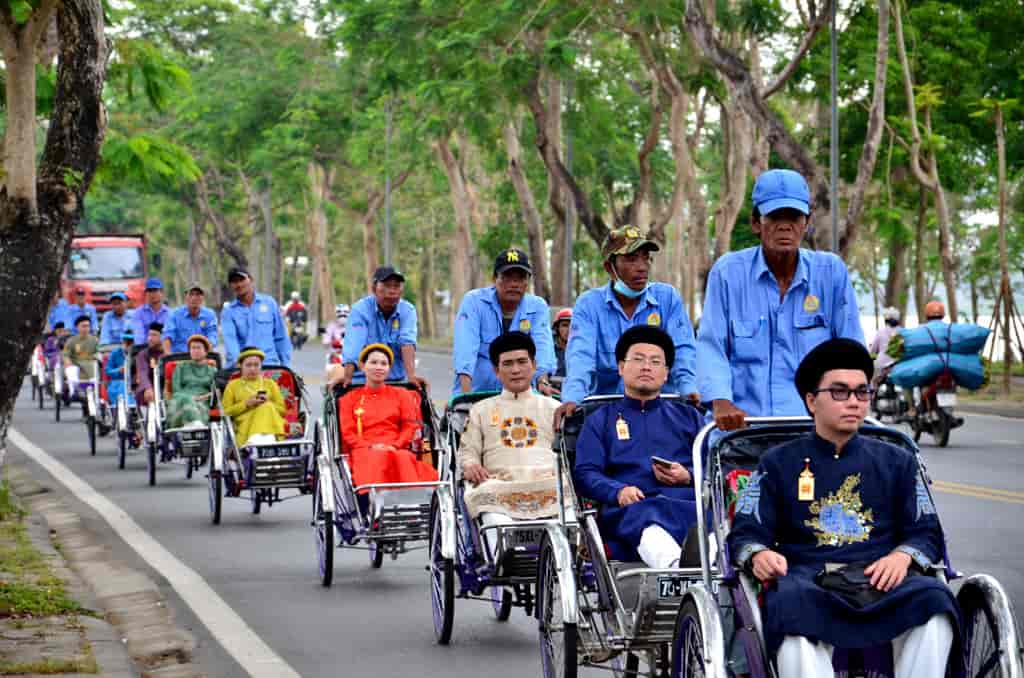
Nighttime Sightseeing
“Hue Imperial City by Night” is an exciting program that offers a chance to experience the royal palace in a dazzling light. You’ll witness traditional ceremonies such as the Changing of the Guard and enjoy performances of Minor and Major Music. The program also features traditional folk games, creating a vibrant and colorful atmosphere.
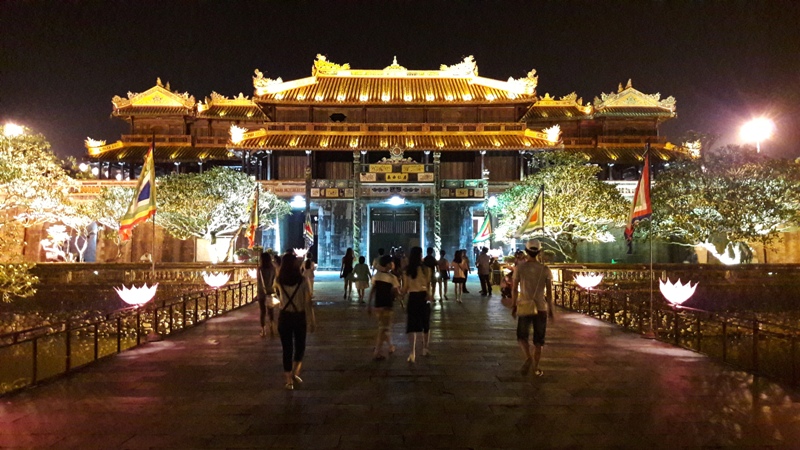
Experiencing Court Festivals
Don’t miss the opportunity to enjoy Nhã nhạc, the Hue Court Music, at Duyệt Thị Đường (Theatre Royal). This unique performance lasts over 30 minutes and features meticulously staged musical acts. You can also participate in the Hue Festival, which includes various cultural, historical, and artistic activities such as the opening ceremony, the Ban Sóc ritual, the Royal Night, and the Court Tet.
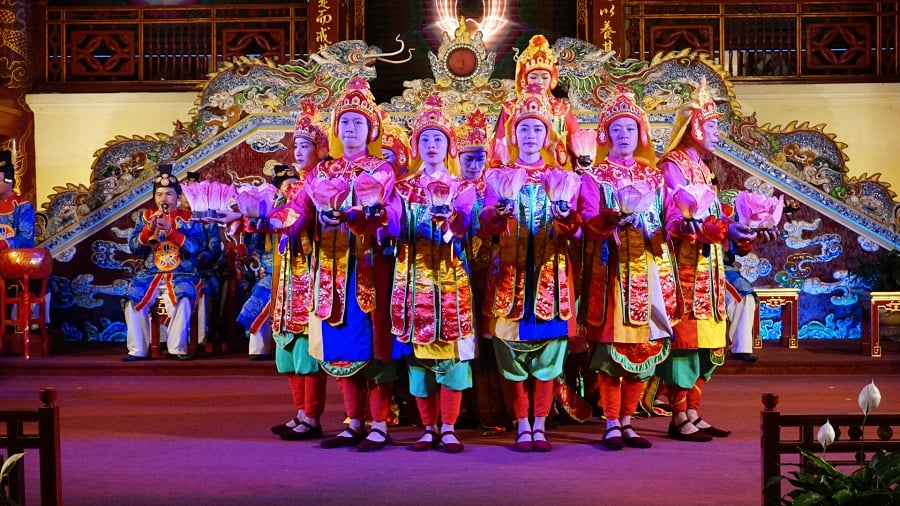
Tea Tasting
Tea tasting at Dien Tho Place is an essential experience. Here, you can relax in the serene garden while sipping on fragrant Hue royal tea and enjoy the beautiful natural surroundings. This experience offers a perfect way to unwind and appreciate the peaceful ambiance of the Imperial City.
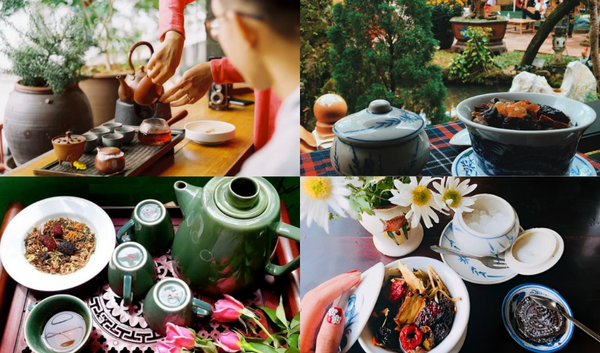
These experiences will give you a deeper understanding of Nguyen Dynasty history and culture while allowing you to enjoy the impressive ambiance of the royal palace.
Visiting Royal Tombs and Palaces
After exploring the Imperial City of Hue, you can also visit the royal tombs of the Nguyen Dynasty rulers. Key tombs include:
- Tomb of Emperor Tu Duc
- Tomb of Emperor Khai Dinh
- Tomb of Emperor Minh Mang
The Hue Monuments Conservation Center offers various tour packages for visiting these sites. The ticket prices for these packages are as follows:
| Tour Package | Adult Ticket Price | Child Ticket Price |
|---|---|---|
| 3 Sites: Imperial City of Hue – Tomb of Emperor Tu Duc – Tomb of Emperor Khai Dinh | 420,000 VND | 80,000 VND |
| 3 Sites: Imperial City of Hue – Tomb of Emperor Khai Dinh – Tomb of Emperor Minh Mang | 420,000 VND | 80,000 VND |
| 3 Sites: Imperial City of Hue – Tomb of Emperor Tu Duc – Tomb of Emperor Minh Mang | 420,000 VND | 80,000 VND |
| 4 Sites: Imperial City of Hue – Tomb of Emperor Tu Duc – Tomb of Emperor Khai Dinh – Tomb of Emperor Minh Mang | 530,000 VND | 100,000 VND |
Note: The validity of these tour tickets is 2 days. Prices are subject to change over time.
Important Tips for Visiting the Imperial City of Hue
When visiting the Imperial City of Hue, consider the following tips to ensure the best experience and to help preserve this cultural heritage:
- Dress Appropriately: To respect the cultural space, wear modest clothing as there are many sacred sites within the complex. Opt for comfortable, neat attire as you will be walking a lot.
- Keep the Area Clean: Maintain cleanliness by not littering and protecting the environment and cultural heritage.
- Avoid Touching Artifacts: To protect the ancient artifacts and architecture, avoid touching them. Do not break branches or pick flowers within the site.
- Take Photos Carefully: If you wish to take photos, follow the guidance provided by the staff of the site.
- Follow Regulations: Adhere to the rules and instructions given by the staff or signage to avoid any issues.
- Read Up Beforehand: Read about the Imperial City of Hue before your visit to gain a better understanding of its history and cultural significance.
Conclusion
In conclusion, the Imperial City of Hue is not only a fascinating historical site but also a showcase of the unique architectural and cultural beauty of Vietnam. We hope this guide has provided you with a comprehensive overview of the Imperial City of Hue from A to Z. Don’t hesitate to plan your trip and experience the wonderful attractions that Hue has to offer!

